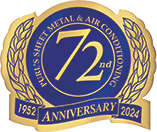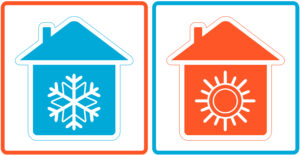Although the word “heat” is included in the term “heat pump,” this high-performance system does more than keep people warm. While these systems can move heat into a home, they can also move heat outside, allowing cool air to blow into a house through the vents. Heat pumps are actually very effective cooling systems because they work exactly like standard air conditioners, but with one key difference: the reversing valve that allows for dual functions.
Much like any other air conditioning system, a heat pump cools a home using a chemical blend called refrigerant. The system is only called a heat pump because it pumps heat into your home during the heating season and pumps heat out of your home in the cooling season. Refrigerant is responsible for the thermodynamic process that allows for this heat exchange to occur.
When you turn on your heat pump during the cooling season, refrigerant first leaves the compressor as a high-pressure gas and makes its way to the condenser. Here, heat releases into the outdoor air during the condensation process that changes the refrigerant into a liquid. The expansion valve allows the pressure of the liquid to drop. Finally, it flows to the evaporator coil, where the liquid refrigerant evaporates into a gas and absorbs heat in the process. An indoor fan then blows cool air into your home.
The reversing valve is the part that differentiates the heat pump from a standard central air conditioner. When you switch the thermostat to heating mode, refrigerant actually flows in the opposite direction, a process unavailable with most central air conditioning systems. When the thermostat engages the reversing valve, refrigerant flows in the opposite direction. When this happens, refrigerant pulls heat from the outside air and moves the heat indoors.
Heat pumps can be very efficient systems for both heating and cooling. Many heat pumps have high SEERs (Seasonal Energy Efficiency Ratios), and a high HSPF (Heating Seasonal Performance Factor). These rating systems give an indication of a system’s average energy use, so you can save money selecting a more efficient system. If you want help selecting energy-efficient heat pumps in Madera, call the experts at Purl’s Sheet Metal & Air Conditioning today!
Continue Reading
Tags: Heat Pump Installation, Madera
Posted in Air Conditioning | Comments Off on How Do Heat Pumps Cool?


